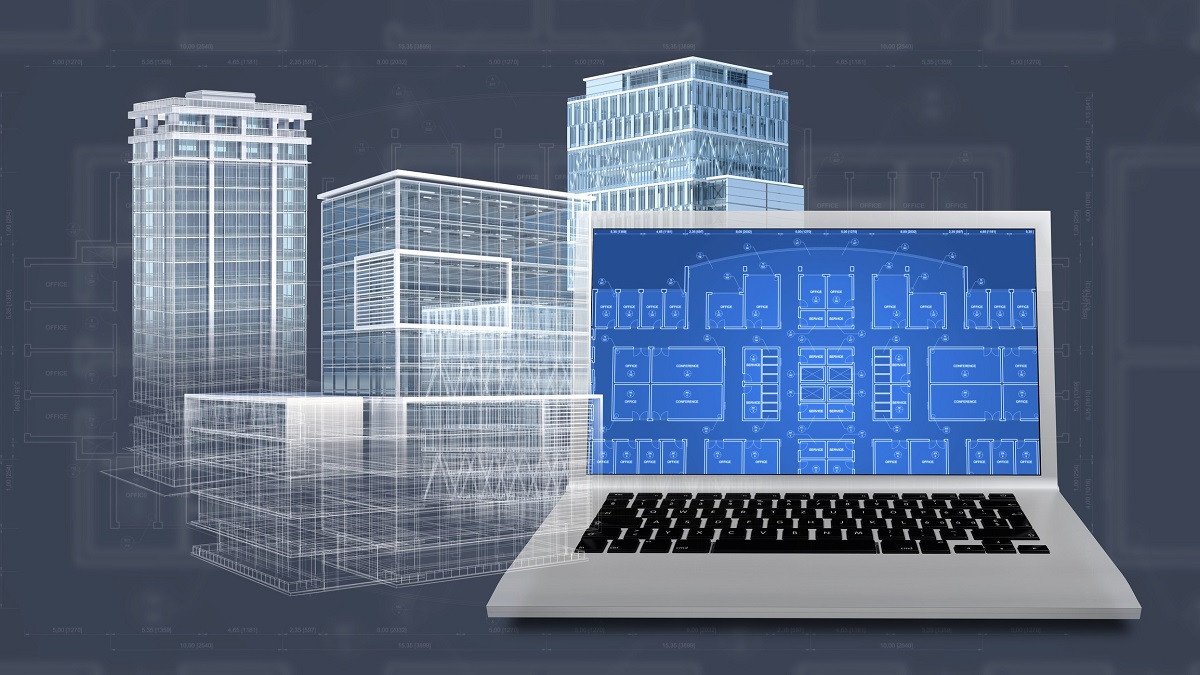Home>diy>Building & Construction>What Is The Difference Between CAD And BIM?


Building & Construction
What Is The Difference Between CAD And BIM?
Modified: October 20, 2024
Discover the key distinction between CAD and BIM in building construction. Learn how these technologies complement each other to streamline design and enhance project collaboration.
(Many of the links in this article redirect to a specific reviewed product. Your purchase of these products through affiliate links helps to generate commission for Storables.com, at no extra cost. Learn more)
Introduction
In the world of building construction, technological advancements have revolutionized the way architects, engineers, and construction professionals work. Two key technologies that have emerged are Computer-Aided Design (CAD) and Building Information Modeling (BIM). While these terms are often used interchangeably, they represent distinct approaches to construction design and management. Understanding the differences between CAD and BIM is crucial for professionals in the industry.
CAD, or Computer-Aided Design, is a technology that has been in use for several decades. It involves the use of software tools to create 2D and 3D models of buildings and their components. CAD allows professionals to draft and design various building elements, including floor plans, elevations, sections, and construction details. It provides precise measurements, accurate scaling, and detailed documentation of the design.
BIM, on the other hand, stands for Building Information Modeling. It is a more advanced and comprehensive approach to construction design and management. BIM utilizes intelligent 3D models to represent the entire life cycle of a building, from its conceptualization to demolition. It incorporates not only the physical elements of the building but also the functional and operational aspects, such as costs, schedules, and material specifications.
While both CAD and BIM focus on generating digital representations of buildings, there are significant differences between the two technologies in terms of functionality, data management, and collaboration. Understanding these differences will help professionals make informed decisions about which technology to implement in their projects.
In the following sections, we will delve deeper into the key differences between CAD and BIM, and examine their respective strengths and applications in the field of building construction.
Key Takeaways:
- CAD focuses on precise visual representations of building components, while BIM integrates data for advanced simulations and multidisciplinary collaboration, enhancing efficiency and decision-making in construction projects.
- CAD is essential for creating detailed drawings and models, while BIM revolutionizes collaboration, data management, and comprehensive building design, improving project outcomes throughout the building lifecycle.
Read more: What Is The Difference Between CAD And Bim
Definition of CAD
Computer-Aided Design (CAD) is a technology that revolutionized the field of architectural and engineering design. It involves using specialized software tools to create detailed digital drawings and models of buildings and their components.
CAD software provides architects and engineers with a range of tools and features to efficiently design buildings. These include drawing tools to create 2D and 3D representations, geometric modeling capabilities for accurately defining shapes and dimensions, and annotation tools for adding text and dimensions to the drawings.
The primary purpose of CAD is to facilitate the design and documentation process. Architects can create detailed floor plans, elevations, and sections of the building, allowing for a clear visualization of the design. CAD also enables precise measurements and scaling, ensuring accuracy in the design process.
One of the key advantages of CAD is its ability to generate detailed construction drawings. These drawings include all the necessary information for builders, such as dimensions, material specifications, and construction details. This helps streamline the construction phase by providing clear instructions to the on-site teams.
CAD software also allows for easy modifications and revisions to the design. Changes can be made to the digital drawings, and the software automatically updates all associated views and documentation. This saves time and reduces errors, as manual revisions can be tedious and prone to mistakes.
Overall, CAD is a powerful tool for architects and engineers to create accurate and detailed digital representations of their designs. It enhances the efficiency of the design process, improves communication between project stakeholders, and provides a solid foundation for the construction phase.
Definition of BIM
Building Information Modeling (BIM) is an advanced and comprehensive approach to construction design, project management, and collaboration. It involves creating and utilizing intelligent 3D models that encapsulate the entire life cycle of a building, from its conception to demolition.
Unlike CAD, which focuses on creating individual digital drawings, BIM takes a holistic approach by integrating various aspects of a building project. BIM models contain not only the graphical representation of the building, but also information related to its components, materials, costs, and schedules. This information is embedded within the 3D model and can be accessed and utilized by all stakeholders throughout the project lifecycle.
The primary purpose of BIM is to facilitate collaboration and coordination among the different disciplines involved in a construction project. The 3D model serves as a central repository of information, allowing architects, engineers, contractors, and other stakeholders to collaborate in real-time and make informed decisions.
BIM models consist of intelligent objects or elements that possess properties and data. These objects can be anything from walls, doors, and windows to HVAC systems and electrical components. Each object not only has a visual representation but also holds important data such as dimensions, material properties, installation requirements, and maintenance schedules.
One of BIM’s key advantages is its ability to simulate and analyze various aspects of the building project. Engineers can perform structural analysis, energy simulations, and clash detection to identify potential conflicts and optimize the design. This helps save time, reduce costs, and improve the overall performance of the building.
BIM also facilitates efficient project management by allowing for accurate quantity take-offs, cost estimation, and scheduling. Changes made to the BIM model automatically update all associated information, ensuring consistency and eliminating the need for manual updates.
In summary, BIM is a comprehensive approach that utilizes intelligent 3D models to integrate all aspects of a building project. It promotes collaboration, improves decision-making, and enhances the overall efficiency and accuracy of the construction process.
Key Differences between CAD and BIM
While CAD and BIM are both digital technologies used in the field of building construction, there are significant differences between the two approaches. Understanding these differences is essential for professionals in the industry to choose the right tool for their specific needs. Here are the key differences between CAD and BIM:
- Scope: CAD is primarily focused on creating 2D and 3D digital drawings of individual building components, such as floor plans and elevations. BIM, on the other hand, takes a more comprehensive and holistic approach by capturing the entire life cycle of a building in a 3D model.
- Data Integration: CAD software focuses primarily on graphical representations of the building. It does not have the ability to store and integrate detailed information about the building components. BIM, on the other hand, incorporates rich data within the 3D model, including dimensions, specifications, costs, and schedules.
- Visualization and Simulation: CAD provides visual representations of building components, allowing designers to see how the elements fit together. However, it lacks the ability to simulate and analyze the performance of the building. BIM, on the other hand, allows for simulations and analyses such as structural analysis, energy performance, and clash detection.
- Collaboration: CAD software is primarily used by individual designers and drafters to create drawings. It does not facilitate efficient collaboration among multiple stakeholders. BIM, on the other hand, promotes collaboration by providing a centralized platform for all stakeholders to access and share information.
- Change Management: CAD requires manual updates and revisions to individual drawings, which can be time-consuming and prone to errors. BIM, on the other hand, automatically updates all associated views and data when changes are made to the model, ensuring consistency and reducing errors.
These differences highlight the progression from CAD to BIM and the advantages of adopting a BIM approach. While CAD is useful for creating detailed drawings and 3D models, BIM offers a more comprehensive and collaborative approach that integrates data and allows for simulations and analyses. However, it’s important to note that both CAD and BIM have their own applications and can be used in conjunction with each other in a construction project.
Comparison in Terms of Functionality
When comparing CAD and BIM in terms of functionality, it becomes evident that both technologies serve different purposes and offer distinct capabilities. Understanding these differences is crucial for professionals in the building construction industry to determine which tool suits their needs. Let’s explore the comparison in terms of functionality:
CAD Functionality: CAD software is primarily focused on creating 2D and 3D digital drawings of building components. It provides a range of tools and features that enable precise drafting and design, allowing professionals to create accurate representations of individual elements such as floor plans, elevations, and sections. CAD allows for the creation of detailed construction drawings, complete with dimensions, notes, and material specifications. It offers various drafting and modeling tools to support the design process.
BIM Functionality: BIM takes functionality to a higher level by incorporating intelligent 3D modeling capabilities. In addition to creating visual representations of building components, BIM stores and integrates detailed information about those components. This includes geometric data, such as dimensions and quantities, as well as non-graphical data, such as material properties, costs, and schedules. BIM models offer object-oriented functionality, where each element in the model contains both graphical and data attributes. This allows for advanced simulations, clash detection, and analysis of the building’s performance.
Differences in Functionality: The primary difference in functionality between CAD and BIM lies in the level of information and intelligence within the model. CAD focuses on creating visual representations and lacks the ability to store and manage detailed data about the building components. BIM, on the other hand, goes beyond visuals and provides extensive data integration, allowing for advanced analysis and simulations. BIM models enable professionals to evaluate the structural integrity, energy efficiency, and cost implications of the design. It facilitates better decision-making and enhances the overall efficiency and accuracy of the construction process.
Usage in Practice: CAD is widely used in architectural and engineering firms for creating detailed drawings and models. It is particularly useful for designers and drafters who need precise representations of building components. BIM, on the other hand, is becoming increasingly adopted due to its comprehensive functionality. It is being used by architects, engineers, contractors, and facility managers to collaborate, coordinate, and manage the entire life cycle of a building project.
Ultimately, the choice between CAD and BIM depends on the specific requirements of the project and the needs of the professionals involved. CAD is more suitable for tasks focused on drafting and visual representation, while BIM provides a broader set of functionalities for data integration, analysis, and collaboration. In many cases, a combination of both CAD and BIM may be used, with CAD for specific design tasks and BIM for overall project management and coordination.
CAD (Computer-Aided Design) is primarily used for creating 2D and 3D models, while BIM (Building Information Modeling) is a more advanced process that includes 3D modeling with additional data for construction and facility management.
Read more: What Is The Difference Between BIM And VDC?
Comparison in Terms of Data Management
When comparing CAD and BIM in terms of data management, it becomes evident that BIM offers a more comprehensive and integrated approach. While CAD focuses primarily on graphical representations, BIM incorporates detailed data about building components, enabling better decision-making and collaboration. Let’s explore the comparison between CAD and BIM in terms of data management:
CAD Data Management: CAD software primarily focuses on the creation of 2D and 3D drawings of building components. While CAD allows for the creation of accurate visual representations, it lacks the ability to store and manage extensive data about the components. The data associated with CAD drawings is typically limited to basic details such as dimensions, annotations, and material specifications. CAD files are predominantly graphical in nature and do not provide a robust platform for handling complex data.
BIM Data Management: BIM, on the other hand, is built on the premise of data integration and management. BIM models store comprehensive data about building components, including geometric data, performance data, cost data, and scheduling information. The data within BIM models is organized using a structured approach, ensuring consistency and enabling easy access and updates. BIM models serve as centralized repositories that contain all the necessary information for various stakeholders involved in the project, facilitating collaboration, coordination, and better decision-making.
Differences in Data Management: The key difference in data management between CAD and BIM lies in the level of information and integration within the models. CAD is primarily focused on graphical representations, with limited data associated with the drawings. BIM, on the other hand, incorporates extensive data within the 3D model itself. This data includes not only visual details but also information about the components’ specifications, quantities, performance, and costs. BIM facilitates a more integrated and intelligent approach to data management, which allows for better analysis, simulations, and planning throughout the building lifecycle.
Advantages of BIM Data Management: The comprehensive data management capabilities of BIM offer several advantages in the construction industry. BIM allows for better visualization and understanding of the building project by providing data-rich models. It enables efficient quantity take-offs, cost estimation, and scheduling through the integration of data within the model. BIM also facilitates clash detection and coordination among the different disciplines, reducing errors and conflicts. The ability to simulate and analyze various aspects of the building project, such as structural integrity and energy efficiency, further enhances the decision-making process.
In summary, while CAD focuses primarily on graphical representations, BIM goes beyond visuals and offers a more robust and integrated approach to data management. By incorporating comprehensive data within the 3D model, BIM allows for better collaboration, analysis, and decision-making throughout the building lifecycle. This makes BIM a powerful tool for professionals in the construction industry who require efficient data management and utilization.
Comparison in Terms of Collaboration
Collaboration is a critical aspect of any successful construction project. When comparing CAD and BIM in terms of collaboration capabilities, it becomes evident that BIM offers significant advantages over CAD. BIM provides a centralized platform for all stakeholders to access, share, and collaborate on project data, leading to improved communication, coordination, and efficiency. Let’s explore the comparison between CAD and BIM in terms of collaboration:
CAD Collaboration: CAD software is primarily designed for individual designers and drafters to create digital drawings of building components. While CAD files can be shared among team members, collaboration is often limited to exchanging files and reviewing designs offline. Multiple versions of files can lead to confusion and potential errors. Communication between stakeholders is typically done through emails or meetings, which can be time-consuming and prone to miscommunication. This lack of real-time collaboration limits the ability to make quick decisions, address issues, and ensure coordination among team members.
BIM Collaboration: BIM, on the other hand, revolutionizes collaboration in the construction industry. BIM models serve as a centralized platform that enables real-time collaboration among all stakeholders, including architects, engineers, contractors, and facility managers. With BIM, multiple disciplines can work concurrently on the same model, making changes and updates that are immediately reflected across all views and associated data. This collaborative approach eliminates the need for manual file sharing and reduces the risk of errors and inconsistencies.
Differences in Collaboration: The key difference in collaboration between CAD and BIM lies in the level of shared information and real-time interaction. CAD relies on file-based collaboration, with limited shared data and lack of real-time synchronization. BIM, on the other hand, allows for seamless collaboration through a shared data environment. Changes made by one stakeholder are instantly reflected for all others, ensuring that everyone is working with the most up-to-date information. This enables effective coordination, improved decision-making, and streamlined communication among team members.
Advantages of BIM Collaboration: BIM’s collaborative capabilities offer several advantages in the construction industry. Real-time collaboration allows for enhanced communication and coordination, reducing the chances of errors and conflicts. Stakeholders can easily access and share information within the BIM model, promoting transparency and alignment across the project. The ability to work concurrently on the same model fosters true multidisciplinary collaboration, enabling early detection of clashes and conflicts. BIM also facilitates improved project management through shared calendars, task assignments, and progress tracking.
In summary, while CAD collaboration is often limited to file exchange and offline discussions, BIM provides a more dynamic and collaborative environment for construction professionals. By facilitating real-time collaboration, seamless data sharing, and multidisciplinary coordination, BIM enhances communication, minimizes errors, and improves overall project efficiency.
Application Areas for CAD
CAD (Computer-Aided Design) technology has a wide range of applications in the building construction industry. CAD software is fundamental for creating precise and detailed digital representations of building components. Let’s explore some key areas where CAD is commonly used:
- Architectural Design: CAD plays a crucial role in architectural design, allowing architects to create digital drawings of building plans, elevations, and sections. It enables them to visualize and communicate their design ideas accurately.
- Structural Engineering: CAD is extensively used in structural engineering to design and analyze building structures. It helps engineers create detailed drawings of structural elements such as beams, columns, and foundations, ensuring structural integrity.
- Mechanical and Electrical Design: CAD software facilitates the design and documentation of mechanical and electrical systems within a building. It allows for the creation of accurate drawings of HVAC systems, plumbing layouts, electrical wiring, and equipment.
- Interior Design: CAD is an essential tool for interior designers to create digital floor plans, furniture layouts, and detailed drawings of custom-designed elements. It allows for precise visualization and material selection.
- Construction Documentation: CAD is used extensively for creating construction documents, including detailed drawings, specifications, and schedules. These documents provide builders with all the necessary information for constructing the building accurately.
- Urban Planning: CAD contributes to urban planning by enabling the creation of digital maps, site plans, and zoning drawings. It helps in visualizing and analyzing proposed developments within an urban context.
- Facility Management: CAD software is employed in facility management to create digital representations of existing buildings. It allows for the documentation of building layouts, equipment locations, and maintenance schedules.
- Renovation and Retrofitting: CAD aids in the renovation and retrofitting of existing buildings by creating accurate as-built drawings. It enables architects and engineers to plan modifications and additions effectively.
CAD technology has transformed the design and documentation process in the building construction industry. Its applications are extensive, ranging from initial design conceptualization to detailed construction documentation. CAD not only enhances the precision and accuracy of designs but also improves communication, collaboration, and decision-making among project stakeholders.
Application Areas for BIM
BIM (Building Information Modeling) technology has revolutionized the construction industry by providing a comprehensive and collaborative approach to building design, documentation, and management. BIM utilizes intelligent 3D models to capture and integrate data throughout the entire building lifecycle. Let’s explore some key application areas where BIM is commonly used:
- Design and Visualization: BIM provides architects and designers with a powerful tool to create detailed 3D models of buildings. It allows for visualizing and simulating the proposed design, helping stakeholders better understand the project and make informed decisions.
- Quantity Take-Off and Estimation: BIM enables automatic quantity calculations based on the 3D model, allowing for accurate quantity take-offs and cost estimations. This helps in better planning and budgeting for the construction project.
- Structural Analysis and Simulation: BIM models can be used for structural analysis, helping engineers evaluate the performance and integrity of the building’s structure. It allows for simulations to test different design scenarios and optimize structural efficiency.
- Energy Performance Analysis: BIM incorporates elements such as building materials, insulation, and HVAC systems, enabling energy performance analysis. This helps in optimizing energy efficiency and sustainability of the building design.
- Clash Detection and Conflict Resolution: BIM facilitates clash detection by identifying potential clashes and conflicts between different building components, such as pipes conflicting with structural elements. This helps in resolving issues early on, avoiding costly rework during construction.
- Construction Planning and Sequencing: BIM allows construction teams to plan and visualize the construction process, incorporating information about the sequence of activities, materials, and equipment. This helps in optimizing construction workflow and reducing project duration.
- Facility Management and Maintenance: BIM models provide a wealth of information for facility managers, including equipment locations, maintenance schedules, and information on building systems. This facilitates efficient facility management and maintenance throughout the building’s lifecycle.
- Digitization of Existing Buildings: BIM can be used to create accurate 3D models of existing buildings, supporting renovation and retrofitting projects. It helps in understanding the building’s condition, planning modifications, and analyzing the impact of changes.
BIM’s applications are extensive, covering various stages of the building lifecycle. From early-stage design to construction, facility management, and renovation, BIM facilitates better collaboration, data integration, and decision-making. Its ability to capture and use rich data within the 3D model enhances productivity, efficiency, and overall project outcomes.
Conclusion
In the world of building construction, both CAD (Computer-Aided Design) and BIM (Building Information Modeling) play critical roles in the design, documentation, and management of projects. While CAD focuses on creating detailed digital drawings and 3D models of building components, BIM takes a more comprehensive approach by integrating data and intelligence within a 3D model that represents the entire building lifecycle.
The key differences between CAD and BIM lie in functionality, data management, and collaboration. CAD excels in precise drafting and design, providing accurate visual representations of building components. It is widely used in architectural, engineering, and construction firms for various design tasks. BIM, on the other hand, goes beyond visuals and incorporates extensive data within the model, enabling advanced simulations, clash detection, and analysis. BIM’s collaborative capabilities allow for real-time interaction, seamless data sharing, and multidisciplinary coordination, enhancing communication and decision-making among project stakeholders.
In terms of application areas, CAD finds its usage in architectural design, structural engineering, mechanical and electrical design, construction documentation, urban planning, and more. It is particularly useful for creating precise drawings and models of building components. BIM, on the other hand, is widely used in design and visualization, quantity take-off and estimation, energy performance analysis, clash detection, construction planning, facility management, and renovation projects. It offers a holistic and collaborative approach to building design, improving efficiency and accuracy throughout the building lifecycle.
It is important to note that CAD and BIM are not mutually exclusive, and they can be used together in a construction project. CAD provides precise visual representations, while BIM offers a comprehensive platform for collaboration and data management. The choice between CAD and BIM depends on the specific needs of the project, the scope of the work, and the requirements of the stakeholders involved.
In conclusion, CAD and BIM are vital technologies that have transformed the building construction industry. CAD provides detailed digital drawings and models, while BIM offers a holistic approach by integrating data and facilitating collaboration. Both technologies have their respective strengths and applications. Professionals in the industry must understand the differences and choose the appropriate technology to achieve successful project outcomes.
Frequently Asked Questions about What Is The Difference Between CAD And BIM?
Was this page helpful?
At Storables.com, we guarantee accurate and reliable information. Our content, validated by Expert Board Contributors, is crafted following stringent Editorial Policies. We're committed to providing you with well-researched, expert-backed insights for all your informational needs.














0 thoughts on “What Is The Difference Between CAD And BIM?”